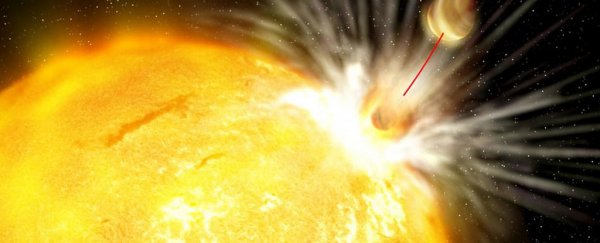Scientists have discovered two new exoplanet candidates orbiting a star some 300 light-years from Earth, and early indications suggest that this distant solar system harbours a dark, turbulent history.
The star in question, called HIP 68468, is what's called a solar twin, meaning it's similar to our own Sun in terms of temperature, age, and composition. But HIP 68468 looks to have consumed and destroyed one of the worlds that once orbited it, thanks to some tell-tale signs left behind at this (alleged) cosmic crime scene.
An international team of astronomers led by Jorge Melendez at the University of São Paulo in Brazil studied HIP 68468 using the 3.6-metre telescope at the La Silla Observatory in Chile, and detected two new planet candidates in orbit around it.
One of these – called HIP 68468c – is a super-Neptune, meaning an astronomical object that is more massive then the planet Neptune. In this case, HIP 68468c has a mass about 50 percent larger than that of Neptune, and about 26 times Earth's mass.
The other new planet candidate – HIP 68468b – is a super-Earth, which is a planet with a mass higher than Earth's, but lesser than Uranus and Neptune.
What's notable about HIP 68468b, which has three times the mass of Earth, is that it's the first super-Earth scientists have found orbiting a solar twin.
But you know how they say 'two's company, three's a crowd'? That appears to be the case with HIP 68468, as a closer look at the star suggests at least one more planet used to orbit HIP 68468 alongside HIP 68468b and HIP 68468c.
When the team analysed the star's composition, they found four times more lithium than they expected for a star of its age – 6 billion years – along with evidence of a surplus of refractory elements: heat-resistant metals that are abundant in rocky planets.
If you're suspecting foul play in distant space might have occurred here, you're not the only one.
"It can be very hard to know the history of a particular star, but once in a while we get lucky and find stars with chemical compositions that likely came from in-falling planets," says astronomer Debra Fischer from Yale University, who was not involved in the research.
"That's the case with HIP 68468. The chemical remains of one or more planets are smeared in its atmosphere."
While the idea of a planet falling into a star and being basically eaten up by it might seem shocking, the phenomenon could be more common than we think.
The researchers are currently monitoring more than 60 solar twins, and they estimate about 15 percent of these Sun lookalikes contain excess lithium.
"This suggests that about 15 percent of stars like the Sun must have devoured planets," says Melendez.
Scientists think our own Solar System could go the same way in enough time too, with projections that the Sun will swallow Mercury, Venus, and potentially even Earth in about a billion years or so.
And if this does happen, it might not even be the first time our Sun has consumed a world.
Research published earlier this year suggests our Solar System might have once contained a super-Earth of its very own – but this world, if it existed, may have fallen into the Sun after straying too close.
Back at HIP 68468, it's possible that the star might be about to become a repeat offender – as both of its surviving planets are already in very tight orbits around it, having migrated inwards from where they would have formed long ago and much further out.
The super-Earth in particular, HIP 68468b, ought to be worried.
Orbiting its star at just 0.03 times the distance between Earth and the Sun, it goes around HIP 68468 in just three days. In other words, it could just be a matter of time before it's pulled in – and we know HIP 68468 has prior form.
"It's as if we saw a cat sitting next to a bird cage," says Fischer. "If there are yellow feathers sticking out of the cat's mouth, it's a good bet that the cat swallowed a canary."
The findings are reported in Astronomy & Astrophysics.
